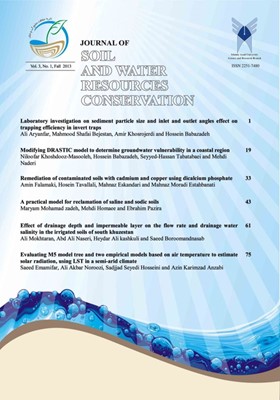Evaluating M5 model tree and two empirical models based on air temperature to estimate solar radiation, using LST in a semi-arid climate
Subject Areas : Farm water management with the aim of improving irrigation management indicators
Saeed Emamifar
1
![]() ,
Ali Akbar Noroozi
2
,
Sadjjad Seyedi Hosseini
3
,
Ali Akbar Noroozi
2
,
Sadjjad Seyedi Hosseini
3
![]() ,
Azin Karimzad Anzabi
4
,
Azin Karimzad Anzabi
4
1 - PhD student, Department of Water Engineering, College of Agriculture, Ferdowsi University of Mashhad, Mashhad, Iran,
2 - Assistant Professor, Soil Conservation and Watershed Management Research Institute, Tehran, Iran
3 - B.Sc., Department of Water Engineering, College of Aburaihan, University of Tehran, Tehran, Iran
4 - B.Sc. student, Department of Water Engineering, College of Aburaihan, University of Tehran, Tehran, Iran
Keywords: air temperature, MODIS, Solar Radiation,
Abstract :
Solar radiation is one of the input parameters needed for simulation of processes associated with climate changes, hydrology and ecology. Proposed models to estimate this parameter because using the weather data from a spatial point, would also provide point estimations. In this study, two experimental models including Hargreaves - Samani and Mahmood - Hubbard that are based on air temperature data, with the input data of daily LST products MOD11A1 and MYD11A1 MODIS instead of air temperature, were used to estimate the solar radiation. The real data were obtained from Ahwaz synoptic station for 2006 and 2007. Validation results indicated that Hargreaves - Samani input MOD11A1 LST product and the model of Mahmood - Hubbard MYD11A1 products with input LST (Land Surface Temperature) have the larger and lowest accuracies in estimating solar radiation. Validation results were further indicated that Hargreaves - Samani input MOD11A1 LST product and the Mahmood - Hubbard input MYD11A1 LST product, respectively, have maximum and minimum accuracy in estimating solar radiation. For these models, R2 and RMSE statistics were, respectively 0.83, 2.46 (mj m-2 d-1), 0.79 and 4.09 (mj m-2 d-1). The Hargreaves -Samani model by using M5 model tree models (RS-M5-1 and RS-M5-2) based on LST data of MOD11A1 MODIS products geographic variables were formulated and the outcomes were compared with results of experimental models. The results showed that compares Tree Model RS-M5-1 and experimental models with the same input, The M5 tree model has higher accuracy. In general, tree model RS-M5-2 with LST products MOD11A1 inputs, can estimate the maximum and actual sundial and extraterrestrial radiation more accurate than other models. For this model, the values of R2 and NSE were estimated to be 0.87 and 0.86, respectively. The root mean square error for this was 10.24 percent.


